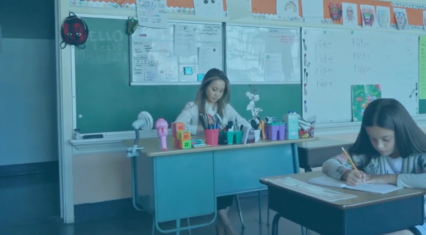Search
Get started
Log into your referral dashboard
Students with special needs or learning disabilities face lifelong challenges with skills like reading, writing, math, and focus. As educators, we want to ensure that no child gets left behind.
To prepare our subs and paraprofessionals for teaching in a special education setting, we’ve compiled 8 tips on how to support students with special needs.
Table of contents
What counts as a learning disability?
- Keep your directions short and concise
- Provide multisensory instruction
- Chunk tasks
- Get attention using nonverbal and verbal cues
- Use positive reinforcement
Special tips for substitute teachers
Your work as a SpEd sub or paraprofessional leaves a lasting and immeasurable mark on students.
What counts as a learning disability?
A learning disability is any challenge with using or understanding spoken or written language, doing math, or directing attention.
To quote our Scoot paraprofessional, Aurrianna, “All students learn and think differently.” Here’s an introduction to a few most common learning disabilities:
- Dyslexia: Reading issues
- Dysgraphia: Writing issues
- Dyscalculia: Math issues
- ADHD: Attention issues
- Executive dysfunction: Organization issues
Between 5-15% of people have a learning disability. Some struggle in only one area, but it’s not unusual for kids to have multiple learning challenges (this is known as co-occurrence).
Most of the time, people don’t outgrow learning disabilities. But there are strategies, supports, and teaching approaches that can help people with learning disabilities thrive.
Strategies for teaching
These are some best practices for communication, monitoring progress, and empowering students who may get easily distracted and unmotivated with completing tasks.
For further information on helping students with specific learning disabilities with reading, writing, math, attention, or organizing, check out Understood.org.
1. Keep your directions short and concise
Include only the necessary information for students to understand what they need to do. For example, you might say, “For the next 10 minutes you will be answering problems 1-5 on this worksheet, quietly at your desk. Please remember to write your name at the top of the paper.”
It can help to model an example with them or ask a student to repeat the instructions you gave back to you to confirm understanding of the task.
2. Provide multisensory instruction
With any information you share in class, use multisensory instruction. Multisensory instruction is a way of teaching that engages more than one sense at a time: touch, movement, sight, hearing, or taste.
Here are some examples of teaching using multisensory instruction:
- To help with reading: Have students break down a difficult word by tapping out each sound in a word using fingers. Students can also draw a word in the air using their arm.
- To help with math: Use blocks and drawings to visualize math concepts in new ways. For example, fractions can be represented by pie charts. 2+2 looks more concrete when you combine four blocks.
- To help with ADHD symptoms: Use movement-based techniques to teach students. Point to the states on a map to practice memorizing them. Or schedule brain breaks to help kids burn excess energy.
3. Chunk tasks
Chunking tasks looks like breaking up an assignment into shorter tasks (either in time or effort) to complete, usually checking in with the student along the way to assess their progress.
Set clear “chunks” by time or quantity. For example, you “chunk” the assignment by telling Lydia to read the first two paragraphs and answer questions 1 to 3 first. Then check in with her and prompt her to read the next 3 paragraphs and answer questions 4-6, and so on.
4. Get attention using nonverbal and verbal cues
Use visual and auditory cues to change from one activity to the next. Practice any attention getters with your students to smoothly run your activities. You could use “Give me five” to silence the classroom or use an egg timer to signal the end of a working session. For more ideas, check out our blog post.
5. Use positive reinforcement
Positive reinforcement is a powerful tool to encourage desired behavior in younger children. Children are more likely to repeat those behaviors when they feel that confidence boost from any of these methods:
- Verbal praise: Make sure to be behavior-specific in your praise like “Great job on cleaning up the art station,” instead of “You’re so smart.” Research shows that praising natural talent or characteristics may threaten self-worth later on.
- Positive notes: When communicating with the lead teacher, mention any good behavior you observed from specific students that day. Children will feel proud when they are praised for their good behavior on multiple occasions.
- Reward system: Develop a way to systematically reward students for completing work on time or participating. Bring a “prize box” with low-cost trinkets like bouncy balls, small animal toys, stickers, notebooks, cute erasers, etc.
- Reward punch card: Hand out flashcards for each student and give away stickers to reward good behavior. You could even use the stickers as currency in exchange for a prize from the “prize box” at the end of the day.
Special tips for substitute teachers
Beyond these strategies, substitute teachers have an unique role to play. They learn to work with existing programs and adopt the full-time teacher’s methods of working with students.
Here are some tips specifically for substitute teachers working in special education settings:
1. Review the teacher’s notes
The full-time teacher should have left instructions and materials to brief you on the lesson plan and mention any students that need special accommodations. Take a thorough look at these notes. If you’re missing them, ask the school admin or next door neighbor for guidance.
2. Ask about accommodations
Talk to a school administrator, paraprofessional, or next door teacher about what accommodations the student you’re supporting today needs in class. These might vary across subjects and types of activities but might include: extra time to complete assignments, shortened assignments, questions read out loud to them, frequent breaks during class, etc.
If you apply to Scoot Education, we provide you a point of contact before you begin your work day, so you know who and where to ask questions before class starts.
3. Ask your students
Ask your student how they like to be supported and what kinds of accommodations they normally receive. This can help kids open up a bit more and give you insight on how to best work with them that day.
However, it’s never appropriate to ask what disability a child has or try to guess. Not only is this insensitive to the child, this is confidential information exclusive to the child’s IEP team.*
*An IEP is an Individualized Education Program (sometimes referred to as an Individualized Education Plan). It is a legal document that lays out the program of special education instruction, supports, and services a child needs to make progress in school. Each IEP is designed to meet a student’s unique needs
Your work as a SpEd sub or paraprofessional leaves a lasting and immeasurable mark on students.
The effect you have as a SpEd sub or paraprofessional on students is profound and goes beyond words.
Every kid needs a teacher who believes in them, especially students who find themselves in special education settings. They tend to struggle with self esteem issues on top of their learning difficulties.
Use these strategies and you can make a lasting difference in students’ lives. Lead with compassion and work with the school’s support systems for special needs, and you’ll increase equity and inclusion for all diverse learners—one school, one classroom, one child at a time.
Would you like even more support when you sub in SpEd classrooms?
Special education settings can be a daunting situation for most first-time subs. Who do you ask about a child’s accommodations? What do you do when student behavior goes south?
Apply to be a substitute teacher with Scoot Education. We’re an educational staffing company. We provide all our educators with personalized, professional support to be the best teacher you can be! That means you get:
- Training resources to sharpen your skills in classroom management, lesson internalization, and more
- A personal Education Consultant who works closely with you and provides feedback should you ask for it
- Flexibility to work when you want
- More job opportunities, more fun!






